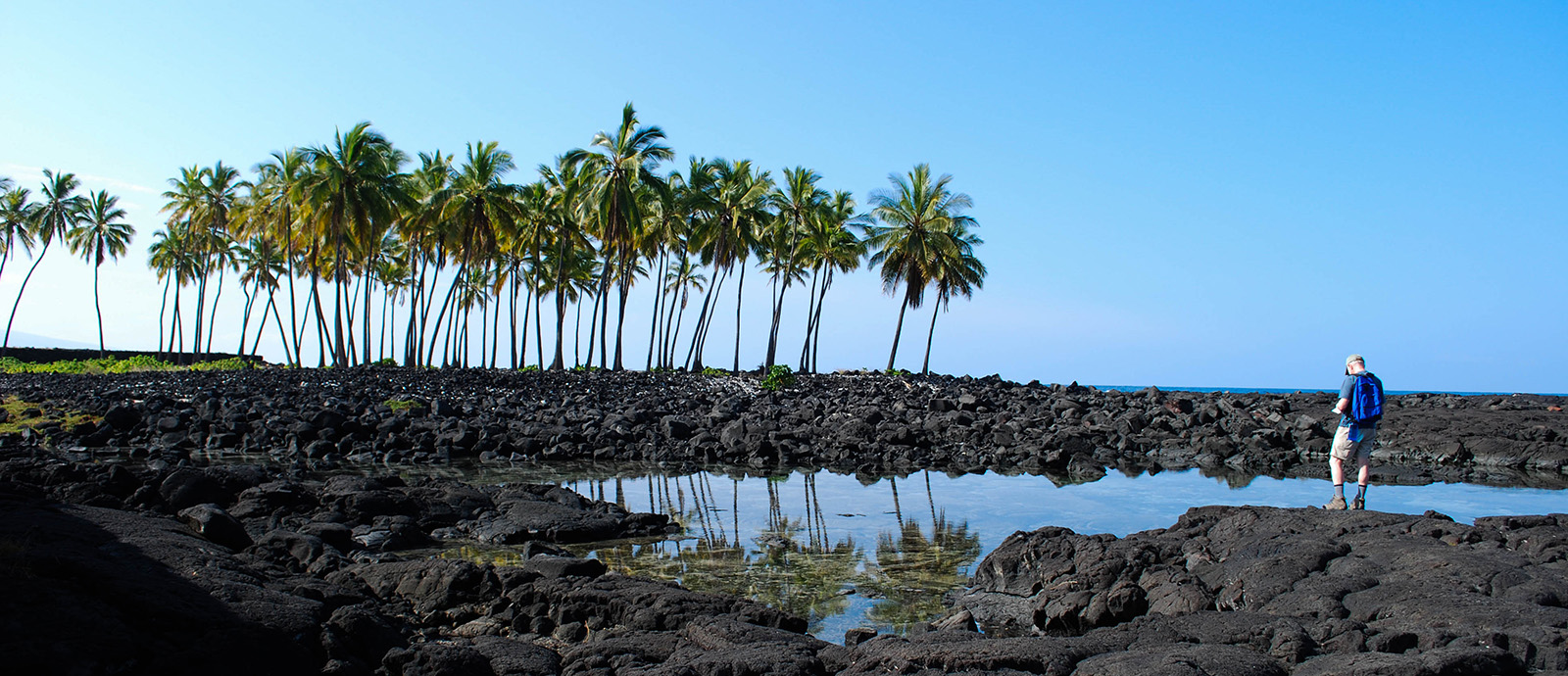Overview
Aloha! Experience the natural beauty of the Big Island on this Hawaiian adventure. Visit a dramatic variety of the many landscapes that Hawaii has to offer. Explore Volcanoes National Park and hike trails to crater rims, cloud forests, and lava flows. Soak up the sun and watch sea turtles munching on seaweed in the surf. Trek through several of the Big Island’s unique ecosystems and visit the southernmost city in the U.S. Spend a few days along the beaches at the northern tropical end of the island hiking the coast, and swimming in the beautifully clear waters of the Pacific Ocean. Hawaiian culture and history will fascinate and delight you! Lodging is provided in comfortable hotels and locally owned cottages.
Sample Itinerary
Expand All FieldsDay 1: Aloha! Welcome to the Big Island of Hawaii
Meet your trip leader at the airport in Kona on the Big Island of Hawaii, then check in to your Kona lodging. In the evening, get to know your fellow participants as you enjoy dinner together, preparing for a week of exploring the Big Island.
Day 2: Snorkel at Kahaluu Beach and spend the afternoon at the historic Pu'uhonua o Honaunau National Park
Wake up to continental breakfast at your hotel before heading out to spend the morning snorkeling or swimming at Kahaluu Beach. Learn about the types of fish, turtles and marine life in the area while viewing them in their natural habitat. Enjoy lunch with the group before spending the afternoon at the beautiful, historic Pu'uhonua o Honaunau National Park. Here you will explore an ancient Hawaiian village site, hike the 1871 Trail, and even catch a chance to cool off with a nice swim. Return to your lodging in Kona and enjoy another delicious dinner as a group.
Day 3: Begin your day at Hapuna Beach State Park, followed by a visit to Pu'ukohola Heiau
Rise early to begin travel to the northern end of the Island. Enjoy morning activities at the gorgeous Hapuna Beach State Park – a spectacular oasis that has earned a reputation as one of Hawaii Island’s finest white sand beaches. In the afternoon you’ll visit Pu'ukohola Heiau- the temple of Kamehameha the Great, and one of the most sacred places in Hawaii. We will end our afternoon with a hike to view ancient pictographs in the area before returning for our final night in Kona.
Day 4: Encounter Sea Turtles at the black sand beach at Punalu'u
Pack up and head to the beautiful historic park Kaloko-Honokohau. Here we will spend time hiking on a beautiful beach with opportunities to swim and explore tide pools teeming with life. In the afternoon we’ll visit the dramatic Black Sand Beach at Punalu'u where you may see Hawksbill Turtles and Green Sea Turtles munching seaweed and resting on the beach. After your beach explorations, check into locally owned lodging in Pahala.
Day 5: Explore the various ecosystems of Volcanoes National Park
Tour a local coffee mill followed by a loop hike into a deep, rarely visited, agricultural valley. Spend the rest of the day hiking in Volcanoes National Park to explore a wide range of habitats and ecosystems, surrounding Kilauea Caldera including Nahuku (Lava Tube), Kilauea Iki, and Overlook and Devastation trails. Take in more sights along the Crater Rim road and follow Chain of Craters Road leading to Pu'u Loa Pretroglyphs. Return to Pahala for a good night’s rest.
Day 6: Enjoy hikes within Hawaii's Volcanoes National Park
Rise early to a healthy breakfast and return to Volcanoes National Park for one last day of hiking on any of the unexplored trails surrounding Kilauea Caldera. From here, we'll continue our journey west to Hilo for our final night at a Hilo seaside hotel.
Day 7: Enjoy one final adventure to Akaka Falls before saying farewell to your trip mates
In the morning, pack your belongings before your final Hawaiian breakfast then head towards the north side of the island on your way back to Kona. If time permits we will stop along the way visiting Akaka Falls and enjoy one last lunch together. Transportation back to the Kona airport will be provided on this day. Mahalo!
Dates & Fees
Wilderness Inquiry leads trips to Hawaii but currently has no dates scheduled. If you have a group of people interested, we can set up a customized adventure just for you! Please contact us or request a trip quote below if you are interested in a group trip to this destination.
Request Trip Quote »What to Expect
TERRAIN/ROUTE: Many of the trails on the Big Island of Hawaii are fairly flat and easy, with gentle ups and downs. Others are more rugged. Trails may present obstacles like roots and rocks, and some sections may be steep. Volcanic rock is brittle and sharp, so sturdy shoes are important. To protect the fragile ecosystem, Wilderness Inquiry uses Leave No Trace travel techniques.
Read more »
